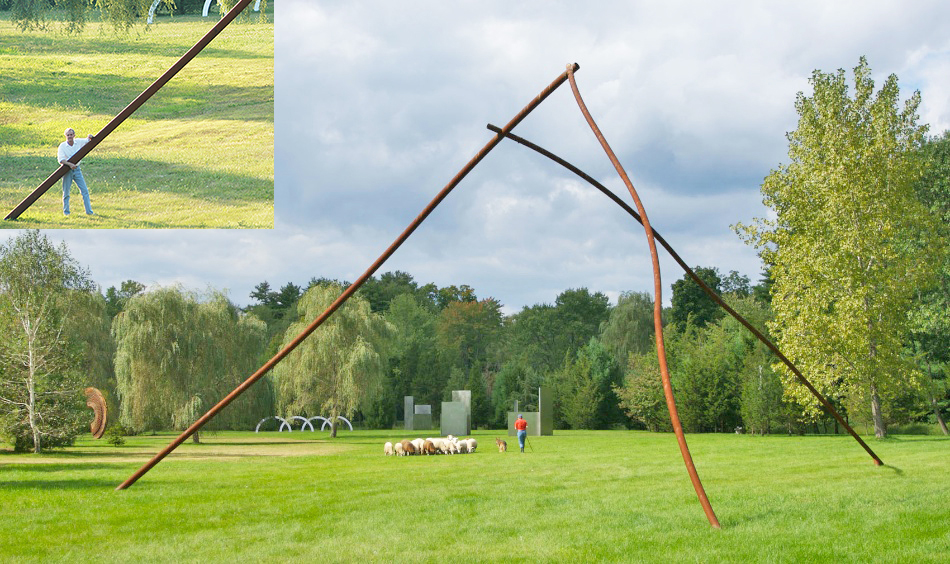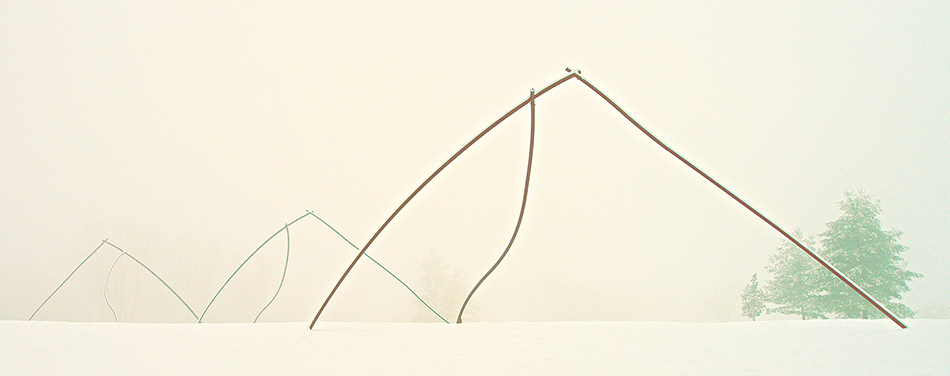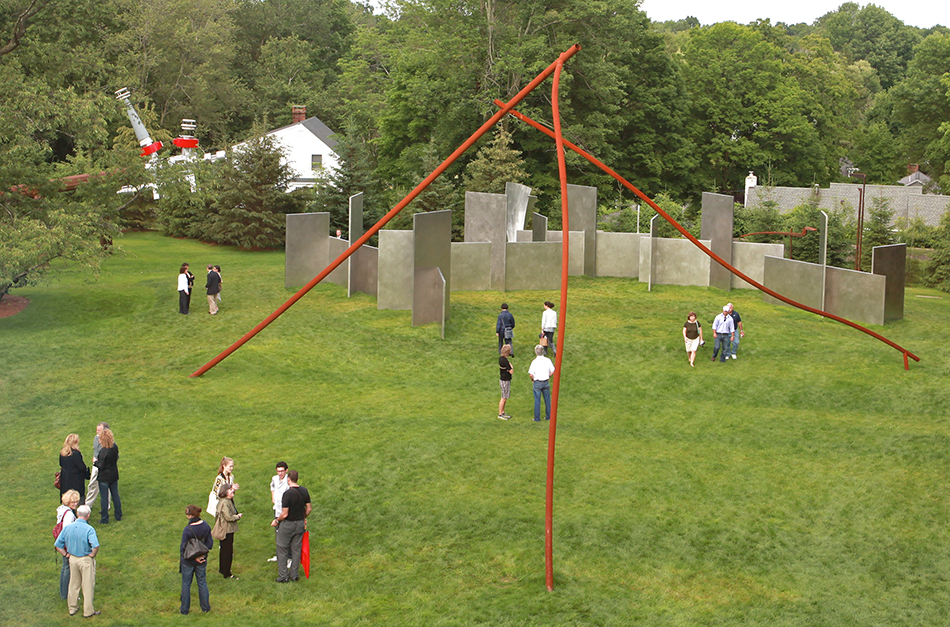|
All 5 books, Edward Tufte paperback $180
All 5 clothbound books, autographed by ET $280
Visual Display of Quantitative Information
Envisioning Information
Visual Explanations
Beautiful Evidence
Seeing With Fresh Eyes
catalog + shopping cart
|
Edward Tufte e-books Immediate download to any computer: Visual and Statistical Thinking $5
The Cognitive Style of Powerpoint $5
Seeing Around + Feynman Diagrams $5
Data Analysis for Politics and Policy $9
catalog + shopping cart
New ET Book
Seeing with Fresh Eyes:
catalog + shopping cart
Meaning, Space, Data, Truth |
Analyzing/Presenting Data/Information All 5 books + 4-hour ET online video course, keyed to the 5 books. |
Larkin's Twig
in our sculpture fields, with visiting sheep.
Inset: ET with Larkin's Twig, first in what is now a series.
This piece is 32 feet or 10 meters tall.
With 99%+ air by volume,
it has a lightness,
a non-monumental quality,
a large presence.
It is about airspace, torqued steel lines, shadows.
|
Views looking up to sky at the joinery, with its torquing calligraphy moving in 3-space:

|
A test installation of the second (30 feet high, legs reshaped) Twig at Hogpen Hill Farms.
This is the Aldrich Twig, shown for 9 months in the sculpture garden at
The Aldrich Contemporary Art Museum; it is now in a northern California private collection.

|
Three Twigs, 2012, steel and air, approximately 300 x 70 x 30 feet, or 90 x 30 x 9 meters,
in the snow at Hogpen Hill Farms. Multiple Twigs create complex airspaces both within
and between the Twigs.
|
This video is also available on YouTube and Vimeo
Below, the piece Two Twigs,
generating complex airspaces between the two,
as well as the usual Twig internal airspaces

|

|

|
Three-dimensional calligraphy in the snow and against the sky,
all for free because the piece is outdoors. Note bird silhouette below.

|

|
Above, a scale model, constructed for my show at The Aldrich Contemporary Art Museum,
shows the Twig location (along with little statues of the artist and welder).
The idea is to do whatever it takes to learn about the artwork and its context:
photographs, scale models, full-size mockups, digital models. Here is Larkin's Twig installed at The Aldrich:
|
Larkin's Twig, a day's shadows in an amazing time-lapse video,
which confirms once and for all that the Earth rotates.
This video is also available on YouTube and Vimeo
-- Edward Tufte
The Twigs
This a series of large steel and air landscape artworks.
The first Twig is called "Larkin's Twig" because several years ago Graham Larkin, then a graduate student in Art History at Harvard, worked as my intellectual assistant, teaching me some art history and providing materials to read and think about in a kind of correspondence course and tutorial. When Graham came to visit, he would bring a little something each time, such as a book or, once, a beautiful twig about 12 inches high with a very nice natural geometry and graceful, but not mechanically graceful, curves. For years, Larkin's twig sat in an honored place in our library and then in our kitchen.
Here the little real twig is at Tallix (our sculpture foundry), serving as a 3-dimensional engineering drawing for constructing the big steel Twig.
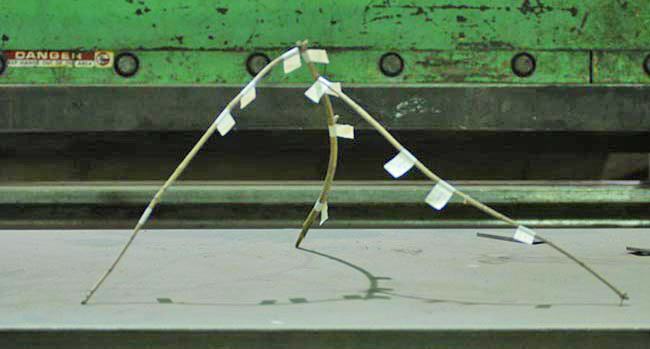 |
Why not make the twig 32 times bigger? How will it scale up? Should X, Y, and Z scale up differently? (Yes) What should the material be? How will the steel rust? What parts should be revised, extended, modified, reshaped? How is it to hit the land? How will it belong in the natural environment of the landscape? In relation to trees, land contours, and other pieces in the field? What is the proper orientation of the piece and the resulting cast shadows? How will shadows vary in different seasons of the year? How can mock-ups be built to test ideas out? What about structural engineering issues? A Cooper's Hawk perched on a two-thirds scale wooden mockup, will that happen on the steel and do we add a bird-perch? What does it all mean? And so on.
Any good 3-dimensional sculpture cannot be captured by one-eyed flatland photographs. One of many tests of good sculpture is that photographs do little justice to the reality. That is, you have to be there. How else can volumes in the air be seen?
-- Edward Tufte
Twig joinery
The 3-dimensional locations of the 2 joints in the piece match the
locations in the original twig. When one cylinder intersects this
way with another, the joint is called a "fishmouth".
But then the leg is expressed and extended about 10" through the adjoining leg to emphasize the flow of the steel tube through the other leg (which does not occur in the original small wood twig). This gesture was made during the fabrication of the piece, as soon as I first saw it up in the air in the foundry. These extensions serve as bird perches.
-- Edward Tufte
Locating a Twig in the landscape
Animated rendering is helpful even though it remains a bit flatlandy; architects use it all the time along with scale models.
Here are the physical, non-electronic methods I tried to get an idea of the Twig in the landscape:
(1) Take a photograph of the 12-inch twig, cut twig out of the photograph, and place cut-out twig image on a landscape photograph. Didn't help. Looked exactly like a cut-out placed on a photograph.
(2) Build a mock-up of the twig out of 4-inch stove pipe. Legs (20 feet and 30 feet long) quickly collapsed under their own weight, despite reinforcing with splines at stove-pipe joints and a lot of duct tape. This experience suggested an impossibility theorem: weight of splines needed to support stove pipe would cause stove pipe to collapse. Lots of left-over stove pipe resulted.
(3) Walk around proposed installation area dangling the 12-inch twig hanging from a stick at some distance from the eyes to simulate real twig. Briefly insightful but gave no sense of volume or of the viewer's physical relationship with the piece, which would require viewer to be 2.25 inches tall. Hard to bring twig, landscape, and viewer together simultaneously.
(4) Build a 2/3 scale model (about 21 feet tall) from tree saplings tied together with threaded rod. Saplings much better than stove pipe. Worked very well, although required a hefty effort to move around to test various locations. Subtle and displaced joints of original twig not replicated by 21-foot tree-sapling mock-up, but no matter. A Cooper's Hawk perched on the top within an hour of placing this model, stayed for 30 minutes scanning the field. Implication: must design final piece to satisfy Bird Factors Department.
(5) Place 12-inch original twig on ground centered underneath 2/3 scale model; try various orientations. This looked a bit strange and provoked comment, but worked well. Some sense of volume was created by 2/3 model along with a sense of accuracy coming from the 12-inch original. Also helpful in assessing shadows.
These preliminaries must produce a good decision because it is a final decision about the location of the piece. The 3 landing points of the 3 legs must be decided in advance of the actual installation. Each landing point has a 6 foot diameter concrete base plate (stock item: sewer system access cover) weighing 3000 pounds buried underground, with crushed stone underneath. Laser level used to align the 3 underground base plates. Base plates positioned and base-plate pits dug a week before final installation (and before the ground is frozen hard). Ground then freezes, allowing cranes and heavy equipment to bring Larkin's Twig into field. No editing allowed on installation day.
Project planning methodologies: several handwritten drafts of sequence on ghost-grid graph paper, many conversations among Tallix, United Concrete, and ourselves. No Gantt charts. Some decisions made incrementally during the process, as each step was monitored and reassessed along the way. Project has its complexities but this isn't rocket science--except for loading and transporting (along I-84 for 90 minutes) the 3 irregular 60-foot legs.
Of course, once installed, if you don't like the view just take a short walk--changing the angle, distance, altitude (land is not flat), or some combination--to have another view. Good 3-D pieces generate a multiplicity of interesting views and volume experiences, which is the point of abstract sculpture (there is no front or side or rear as in the case of representational sculpture such as the Great Leader up on the pedestal). The piece in relation to its landscape position is fairly robust; something outdoors 32 feet tall with a big triangular footprint (about 60 by 60 by 70 feet) will be just fine if placed within a few feet of the optimal position.
This is sometimes called "installation art", as at Donald Judd's Marfa. The piece is located, installed, and at least partly conceived in relation to one place; the piece is meant to reside there for a very long time.
-- Edward Tufte
Comment: spatial exploration
Steps one through five are probably the most enjoyable reading of spatial exploration I've read.
George Perec speaks about hanging a painting on a wall to forget the wall is there. He goes on to explain that, unfortunately, we forget the painting is there through experience, and the wall returns. Of course the difference here is that the Installation isn't meant to make you forget a space, it's meant to define and reinforce the existance of the space it resides in. It's little wonder Installations work best in those secondary spaces around us that we take for granted, such as empty fields, the stunnningly non-existant spaces between terminals at any airport, and the public squares people pass through everyday.
Anyhow, it's a wonderful new thought provoking piece, thanks for opening a thread.
-- Jeffrey Berg (email)
Graham Larkin discovers his twig is now a sculpture
Dear Edward,
I remember that twig! Since this is, to my knowledge, the first 32' monument in my honor, I feel I should officially respond. Indeed, I even feel entitled to digress a little.
You really captured the bounce of the original. And I'm delighted that, despite your minor improvisations, you maintained the opposable toe on the longest leg. I can't wait to see the real thing.
Alas, I will probably have to wait until summer, since I am now teaching seminars in Stanford museums and special collections. For next week's assignment, each student will adopt and catalogue a couple of prints. This means attending to such matters as the medium (including not only the technique and ink color, but also the paper color and texture), the size of the sheet (plus the platemark dimensions, if applicable), and any inscriptions, collectors' marks or watermarks. They will also be remarking on condition--noting, for instance, whether any imperfections or other oddities can be attributed to the plate, the inking, or the subsequent life of the sheet. I know you'll approve of all this close looking, since you were teaching it to me years before we met, by way of your beautifully printed books.
Although I always have my eye on curatorial jobs, I don't mind teaching as long as I can do it with real art, as opposed to slides. Most art historians seem far too content to teach with slides taken from book illustrations, even when there's perfectly good art at hand. And I know that many of my colleagues would find my cataloging assignment impossibly dull, not to mention 'conservative'--as if mere materials were somehow beneath their attention, and as if politics had anything to do with it. I have come to realize that such people are historians of images, whereas I am a historian--or, if they're good enough, a lover--of objects.
You can use that too if you want.
Yours gratefully,
- Graham
-- Graham Larkin (email)
Scaling from very small twig to very large Twig
How is a 16 inch stick (compound curve) converted to a 53 foot steel pipe (compound curve)? Here is the recipe of Kurt Wulfmeyer, head of the fabrication department at Tallix (the famous sculpture foundry in Beacon, New York): Start at one end of the stick, sight down the stick, rotate the stick, identify a section of the compound curve that bends only in 2-space, mark that section. Figure out radius of that curve segment, expressed in final scale (see little tags on twig). Continue building up the stick out of 2-D curves, and scale up the stick sections to sculpture size to make the 3-D steel compound curve. A pipe-bending machine can make the 2-D pieces, which are rotated, appropriately aligned, and welded. This yields a 3-D steel-pipe compound curve weighing about 1,000 pounds. Repeat for the other 2 legs.
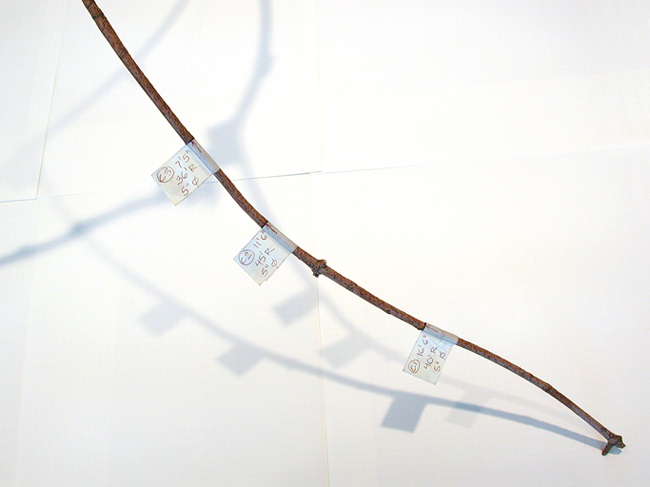 |
-- Edward Tufte
Twig turns into abstract art
It's an abstract twig, with Nature's curves but no representational detailing. That is completely deliberate.
The color (unpainted steel with mill scum that quickly rusts outdoors) and the natural curves make the piece belong in the landscape, and express part of the piece's relation with the landscape.
But the sizing, location, material, surfacing, joinery, expression of the open pipe at the ends, orientation relative to the sun and the environment, cast shadows, landing points, multiplicity of views generated, and the physical experiences of viewers--these represent the art part.
By the way, on-site viewers will never look at a real twig the same way again. Twigs have become art, rather than art representing twigs.
-- Edward Tufte
Comment: representation vs. abstraction
E.T: "By the way, on-site viewers will never look at a real twig the same way again. Twigs have become art, rather than art representing twigs."
You're getting into the semantics of Duchamp, and Magritte's Ceci n'est pas une pipe. Do you have an opinions on the role of art with such ideas? I found it interesting you use the word real. Do you feel Larkin's Twig is a representation of a twig, or is it itself something real, a real twig that tells something about all twigs as a whole?
I saw Larkin's Twig as a real twig, and I did, as you predict, come to some new discovery about twigs, although by simply viewing the photos supplied. I suppose I would discover even more on site.
-- Jeffrey berg (email)
ET on what the Twig means
It is what it is, a visual experience with visual consequences.
In seeing and observing and creating, it is important, perhaps essential, to stay with the visual experience as long as possible. For me, anyway.
Word authority can quickly and easily dominate our vision, and we may come to see only through the lenses of word authority rather than with our own eyes. Unless the words stay close to the visual experience (as in David Smith by David Smith), art-chat is just art-chat.
As Ad Reinhardt said: "Art is Art. Everything else is everything else."
(And these words here are about art, not about analytical design. Analytical design is everything else.)
-- Edward Tufte
Response
Answers like that are why I keep returning to this forum. Thank you.
-- Jeffrey Berg (email)
More on subtleties of scaling
With regard to scaling up the 1 foot twig to the 32 foot piece: the main issue is the diameter of the legs. A 32-fold multiplier yields legs from 10 to 14 inches at various cross-section diameters. Too massive, I decided, staring at the tape measure. So I set the spec for the steel pipes at 4 to 6 inches, got an estimate of fabrication costs, became worried upon seeing a 5 inch steel pipe, decided to go up to 5 to 8 inches on the spec. Foundry re-estimated and raised price, throwing the whole project in doubt.
What to do? Don't just measure diameters, but also look at diameters. Went outside, walked in the woods, measured tree trunks, stared at tree trunks of various diameters, and realized (about time) that the visual presence of a trunk (and therefore a twig leg) depended substantially on the figure/ground contrast (that is, the contrast between the trunk and the background) and not so much on modest changes in trunk diameter. Decided to go back to original plan and therefore the initial (and lower) cost estimate.
Many of the big excellent abstract sculptures are big all around, massive in 3-space (Serra, Lieberman, di Suvero, Calder, Tony Smith). In contrast to these monumental works, Brancusi's Endless Column in Romania moves with great height and slender grace up into the sky. (Brancusi, by the way, experimented with various cross-section sizes in different versions of Endless Column.) I did not want anything suggesting massiveness, just beautiful flowing sturdy-enough elegant lines in the air, with no ambiguity of reading the curves and joinery regardless of background. Diameters of 4 to 6 inches did all this. It helps that the piece sits in an uncluttered open field with long views. Also the legs of Larkin's Twig run diagonally across the trunks of the trees in the background and thereby avoid competing with vertically parallel trunks of living trees. On this, see Twig pictures at the top of the thread.
There are certain practical structural and installation issues. These legs support themselves, and can be picked by a single strap (upside- down V strap configuration). The legs weigh in from 900 to 1,200 pounds a leg, which is quite light by the lifting standards of Tallix and United Concrete which did the rigging and installation (our difficulties arose from the long and awkward length, 55 feet maximum, of the legs). Installed, the legs do oscillate and vibrate a bit if given a good nudge. Of course the piece had been fully assembled and standing at Tallix; it was clear then that the piece wanted to sprawl and therefore required secure mounting at each landing point. Consequently, 3,000 pound concrete bases were buried in the ground, 2 foot square mounting plates welded on the land-end of each leg, and expansion bolts drilled into the concrete at the live installation (so foundry holes in the steel don't have to be pre-aligned with holes in the concrete out in the field).
Of course a thick-pipe version was not built and so direct comparison of various pipe diameters in situ is not possible. I prefer direct visual analysis of a visual problem but, in a finite world, muddling through will have to do.
-- Edward Tufte
Cooper's Hawk and Twig
With regard to the Cooper's Hawk that perched at the top of the 21-foot sapling mockup, here's a picture of our friend about 6 months ago:
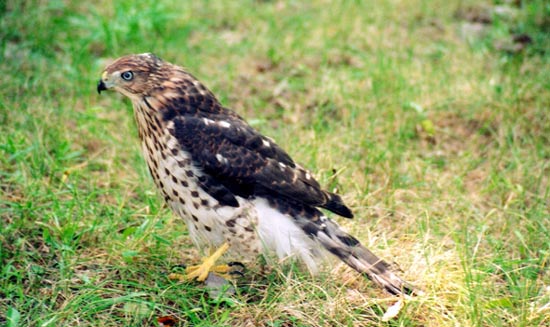 |
I've seen him (a raptor expert identified gender) circling overhead a few times since the installation but no observed stops atop the Twig. Maybe the hawk, my camera, and I will all converge upon Larkin's Twig someday, probably well after this cold windy weather. If he doesn't perch on the piece, I'll rework the Bird User Interface to allow a better grip (look at those talons) up high at the Twig apex.
-- Edward Tufte
Wood perch for Hawk?
Just as a side note, a Hawk will prefer a perch of wood. They claw and peirce their perches. Your raptor may have made an attempt at Larkin's Twig already.
When I was living in New England a large 2x4 extending from a fence post was enough to attract one to a viewable spot.
-- Jeffrey Berg (email)
Perch contrary to art
We planned to weld a threaded steel rod up at the top which would support a foot-long piece of eastern red cedar for the bird perch. This would have to be done during the installation (welding at 32 feet up in the air at the Twig apex in the field = great photograph) because we were not sure of how the piece would level out in the field compared to the factory (on the assumption that the bird would prefer a perch parallel to the ground).
Upon seeing the piece installed, however, I quickly decided for beauty reasons not to add the wooden perch--because the apex is silhouetted so cleanly against the sky, as can be seen in some of the photographs. Am now looking for a way to install a wooden perch that does not compromise the visual integrity of the piece. Or awaiting a successful bird landing atop the metal tube. That is, Bird User Testing.
-- Edward Tufte
Use old tires for bird perches?
One way of providing a perch would be to glue using a good contact adhesive some old truck tyre inner tubing to the upper surfaces of the twig near the top. The best spots would be on the short stubs where the tubes intersect. The rubber should be soft enough for the hawk to get a good grip with his talons. It will last for quite a while. You wouldn't be able to see the rubber from the ground unless you knew what to look for.
From a hawk's view of the world this looks like an ideal hunting perch!
-- Andrew Nicholls (email)
Donald Judd on installation art
"It takes a great deal of time and thought to install work carefully. This should not always be thrown away. Most art is fragile and some should be placed and never moved again. Somewhere a portion of contemporary art has to exist as an example of what the art and its context were meant to be."
-Donald Judd
-- Edward Tufte
Raccoon climbs Twig
Raccoon tracks going up about 25 feet have appeared on Larkin's Twig. The tracks contrast with the newly formed rusty patina. The tracks seem to go only up.
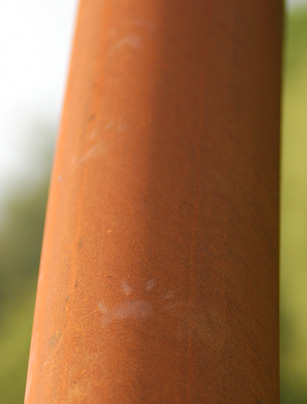 |
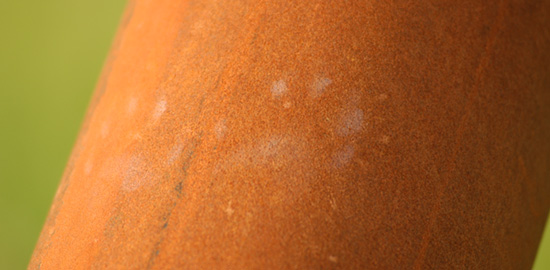 |
-- Edward Tufte
Scaling of Twig by dog size
A sense of the size of Larkin's Twig comes from this snapshot of 3 full-grown Golden Retrievers in the meadow beneath the piece:
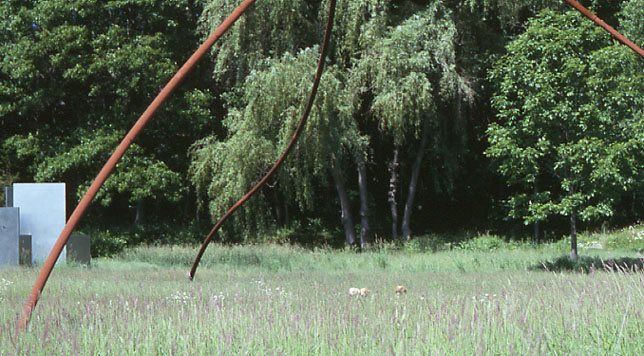 |
-- Edward Tufte
Response to Larkin's Twig
We saw the Cooper's Hawk about 10 times in April and May, although not in the last month. That hawk was injured last year, I wrapped it in a towel, and my wife took it to a raptor hospital, where it miraculously recovered (the picture above was taken when the CH was returned to our land). In late April or early May, one of my colleagues reported that the Cooper's Hawk once landed on Larkin's Twig; I only saw the CH on stamping on the ground with its talons, apparently feeding beneath the Twig. (Appropriately, the name of my lawyer for open space preservation work is Peter Cooper.) The other types of hawks usually around our land and Fresh Meadows show up most every day, often under attack by the crows in aerial combat . Many years ago an expert birder spotted a Golden Eagle over Fresh Meadows, apparently commuting between Fresh Meadows and the Connecticut River.
One of the marvelous things about landscape installation sculptures is the interplay between Nature and the sculpture pieces, as various animals make the pieces part of their world. Sometimes this interplay is rather hard on the pieces, as pigeons are hard on statues of Great Leaders in cities.
-- Edward Tufte
Response to Larkin's Twig
Larkin's Twig is large, up close anyway, compared to people.
On the other hand, scattered over the land are probably 50 trees around 100 feet tall, 3 times the height of the piece. And there are several hundred trees taller than the Twig. Lightning is probably more interested in the trees; in 27 years, on our 22 acres and on the 32 acres of adjacent wildlife sanctuary, there have been 2 noticeable lightning strikes, once on a big tree right next to our house (blew out all the GFI outlets, made a hole in the living room wall) and once in the wildlife sanctuary (causing a small fire). As a result, larger trees near the house, as well as the house, now have lightning rods.
A few weeks ago 10 people went on a tour of the Fresh Meadows sculpture fields and, without thinking about it, we gathered beneath the Twig, surrounded and enclosed by the vague curved planes formed by the lines in the air. I made a little joke about instant karma. The physical experience under the Twig is that of a quiet, separate, different space. There is none of strong sense of physical dislocation produced by Richard Serra's amazing Torqued Ellipses at Dia-Beacon.
The structural issues were investigated by the Tallix foundry, who constructed the piece. A firmly-rooted tripod is a very secure object. This is especially the case since there are 2 separate joints near the top.
-- Edward Tufte
Response to Larkin's Twig
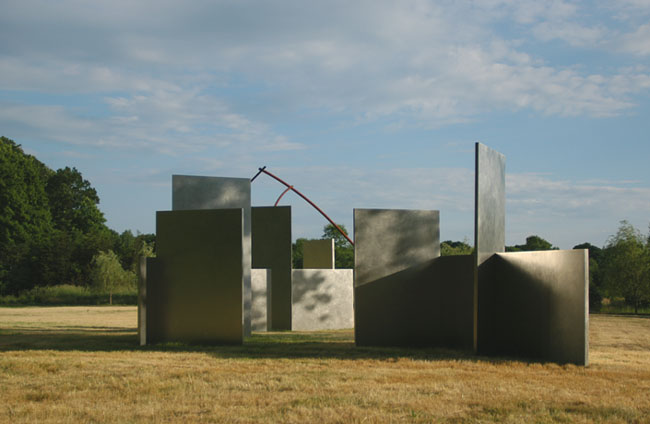 |
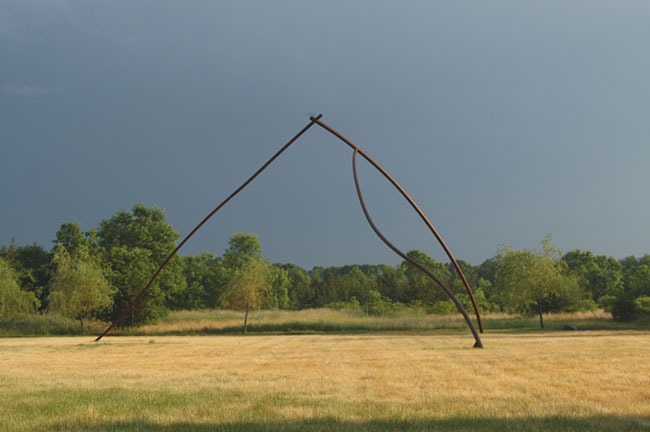 |
-- Edward Tufte
Response to Larkin's Twig
The second picture has a novel illusion: the right-most leg appears to be slightly elevated and in front of the middle leg, which is exactly opposite of truth. The twiggy nature of the sculpture strengthens this by inhibiting any sense of foreshortening. The telephoto lens further removes foreshortening cues. A real shortcoming of flatland photography. Oh, and the land is flat, too!
-- Niels Olson (email)
Response to Larkin's Twig
It's not light but color that causes the illusion. Cezanne said there's no light in painting, only color (one of his most enlightening statements, if you'll pardon the pun). We art students all learned in Color Fundamentals that lighter, "warmer," colored features will tend to come forward visually when juxtaposed against darker, "cooler," colors (though not always). Josef Albers in Interaction of Color writes about the development of spatial relationships in painting brought about by color: "Boucher's receding deepening with vermillion red and Rubens' advancing heightening with white." So, not only does the golden cast of the rear leg bring it visually forward of both the front leg and the cerulean-gray sky, the rust color of the front leg pushes it visually behind not just the rear leg but also the sky, further forcing the illusion that the rear leg is somehow in front of the rest of the sculpture and that its foot must therefore be up in the air.
Contributing to the levitating leg illusion is the visual stability afforded the front leg by the weldment at it's base, thus not only physically but also visually anchoring it to the field in contrast to the unbracketed, and thus "disconnected," rear leg.
The visual field of the meadow is strengthened by the lines introduced by the tracks of the mower. But the shadowy strip running between the front and rear leg (pathway, stream, shallow in the meadow?) creates a little island of grass around the rear leg and tree, making for a discontinuous field of support and giving to the scene a touch of the floating world of Japanese prints and drawings. This illusion is something commonly seen among coastal islands, especially when viewed from a modest height: the broad expanse of open sea removes any linear (perspectival) connection from shore to island, and the island appears to sit upright and float on a plane somewhat higher than we expect. Likewise, the rear leg of Larkin's Twig sits on its island and appears to float just above the plane of the front leg and the more expansive sea of grass. I suspect the illusion holds in the field too, not just in the flattened world of this photograph. If you remove the shadow, the illusion mostly goes away. (The next time any of my fellow correspondents are in southern California on a clear day, head up Crenshaw to Del Cerro Park on the Palos Verdes Peninsula and have a look at Santa Catalina Island; the effect is stunning.)
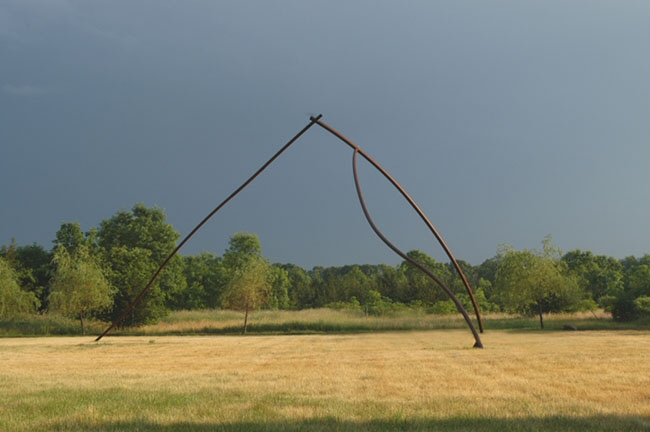 |
All in all, a first rate shot of a classy sculpture.
-- Steve Sprague (email)
Response to Larkin's Twig
I haven't figured this out, but here are some considerations.
The right-rear leg is enlarged by the reflected light and the dark edge that pull it forward visually. The floating effect is lessened when only the lower parts of the 2 right legs are viewed (although that view highlights the thickened base of the right front leg, bringing that leg forward in perspective and perhaps floating the back leg).
The important local horizon (the low green vegetation line) near the intersection of the right 2 legs with the ground is at the far edge of a road behind the piece. The green line abutting the road is from overgrowth on a wet patch in an unkempt field.
The lens was a wide-angle Nikon 20-35 mm f2.8 zoom on a Nikon D100 digital camera. The CCD imaging surface in the digital camera is smaller than the 35mm film rectangle; therefore the nominal 20-35 mm focal length for the zoom is more like 30-53 mm. I think the zoom was set toward the 35 mm (nominal) end, whatever it took to fill the frame. The wide-angle effects are very very strong with this lens, making for interesting but not deadpan documentary pictures if there are such things. The camera was probably quite close to the piece, yet the lens gathered in the big scene.
The local horizon (the dark green line) is tilted along with the whole plane of the yellow grass, with the right side elevated.
I probably took the photograph on my knees, thus the camera angle was tilted upwards since the 35 foot high piece fits easily into the scene. Some of the perspective distortion from the lens and the position of the camera can been seen in the photograph above the Twig, where the Twig just peeks over the Escaping Flatland pieces. That picture was also taken from a position close to the ground. Note the strong perspective recession in the right-most plane there.
There is some pin-cushion effect from the lens, an effect not adjusted out by Photoshop afterwards. There were no other Photoshop adjustments either.
Or maybe the land surface actually rises up toward the back of the piece!
The actual visual scene was striking, rare, memorable; the warm yellow light from the drought-brown grass underlighting the scene against a deep gray-blue sky. That dark gray sky produces "gegenschein" (my private language, not the astronomical term): a magical intensification of color brightness and saturation produced by certain uniformly overcast skies that allow a special filtered light through that makes the colors on the land alive and glowing. Perhaps there is a name for this effect in landscape photography or in books on optical effects outdoors. Of course this visual effect is stronger on a backlight computer-screen than on a reflective printed image. But those reproductions are trivial compared to the real effect.
Finally, there is a close and contrary relationship between photograph and big landscape 3D pieces. One-eyed flatland photographs are hopeless in capturing the live experience of seeing a piece. No environment, no air, insufficient dynamic range if sun and shadow and stainless steel are involved, flatland perspective not reality, no ambulatory seeing (so important for experiencing landscape pieces), and so on. But photographs intensify seeing, have point of view, isolate colors, repay study. Photographs are portable. They do not require a long trail walk on a hot glarey humid day with deer flies buzzing around in order to see the piece. Photographs are different; that makes them interesting.
-- Edward Tufte
Response to Larkin's Twig
Below, a sketch left over from the making of Larkin's Twig at Tallix. Shown is the original 14-inch twig, with estimates of footprint size when built.
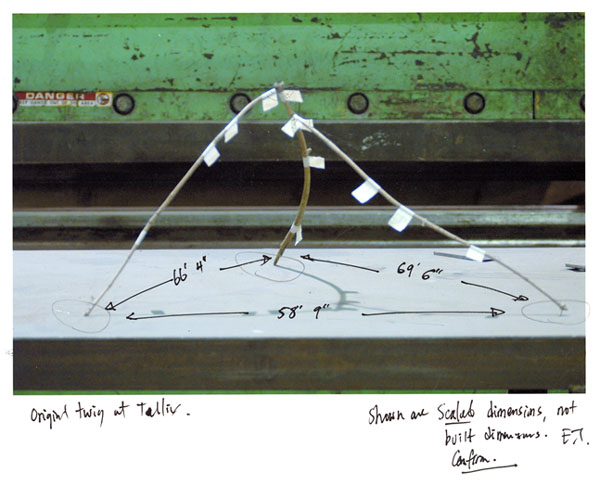 |
-- Edward Tufte
Response to Larkin's Twig
I bumped into this page while bouncing around the net and I find myself thinking about the symbolism of this as it applies to human endeavor. On one hand I'm a little in awe that we as people can take something we find interesting and make it into such a monument to the glory of nature. The scale of the sculpture took my breath away when I saw it with a person standing next to it. On the other hand it goes to show another side of the nature of man-that we see something beautiful in the world(aka-the twig) and decide that it's not good enough to satisfy us, and that to make it better it must be as big as absolutly possible(trying to improve on something God decided was fine the way it was?). Now-keep in mind these comments aren't from an art critic-or even someone that is college educated. I'm just a 35yr old guy that works on cars and trucks and happened to be bored one night in front of the computer. Like I said I didn't go looking for this site, I just bumped into it, but I am grateful that I did. I haven't decided exactly what I feel about the sculpture -but it has made me stop and think. Whatever you may think of this sculpture, it is bound to elicit some response. And I agree wholeheartedly that the twig itself has has an exceptionally flowing and graceful appearance. It has made me look at normal things around me in a new way. For that if nothing else I wanted to say thanks. Cole.
-- Cole (email)
Thanks, Cole.
ET
-- Edward Tufte
Response to Larkin's Twig
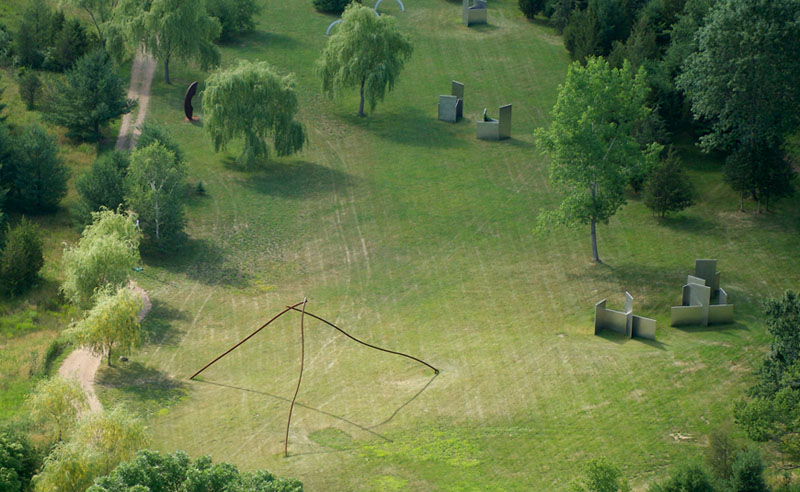 |
-- Edward Tufte
Response to Larkin's Twig
Jon Gavin of United Concrete took my camera and me on a helicopter tour of our landscape sculpture farms.
Here's a compilation of slides showing various views of Larkin's Twig in early August:

-- Edward Tufte
|
||||||||||||||||||||||||||||||||||||||||||||||||||||||||||||||||||||||||||||||||||||||||||


